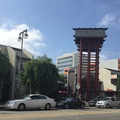When the Sansei went to college, they found a way to understand these contradictions through Ethnic Studies. Their fight for Ethnic Studies and the rediscovery of Japanese American history, Asian American history, and the history of “Third World People” as a whole provided new language to contextualize these experiences. The academic “rediscovery” of Japanese American history and identity was directly linked to a renewed academic and political interest in historic Asian American communities. In the process of recovering histories and historical subjects, activists also began recovering spacesof history: the Nihonmachis (“Japantowns”), the central valley farms, the American concentration camps.
The rediscovery of the incarceration experience, in particular, was essential to forming a cross-generational Japanese American identity and personalizing the political battles over space in Little Tokyo. For many, the incarceration had been a present absence in their lives: they knew that it had happened, yet they did not know what it truly meant. In his monograph on the rediscovery of the incarceration experience, Nakanishi said: “It was not uncommon for third-generation Sansei children who grew up during the post-war decades of the 1950s and 1960s to have acquired only the most basic facts about their elders’ internment experience.”1
Oftentimes, finding out the extent of the incarceration and that it had happened to family members was an overwhelming emotional experience.2 One Sansei I interviewed remembered the first time she talked to her father about the incarceration as such: “At first he was reticent, but once he started talking, he talked until 3 o’clock in the morning... It was really amazing. I got angry. I cried. It was just a real heavy thing.”3
The charged emotions—the catharsis of passing down these painful memories from Nisei to Sansei—allowed for generational reconciliation and understanding. Kunitsugu, reflecting on the impact of the redress movement, said: “Well, I think I really hand it to the Sansei activists that didn't let what happened in the past bother them. Of course, they didn't experience it, so they didn't have the first-hand experience of discrimination. But still... to have done all that is a real accomplishment. And I really admire the people who did that.”4
One of my interviewees remembered how talking about the camps changed her relationship with her father. “I felt like I could say a lot to him... He worked at a bank so he was very conservative in a certain way, but he really understood what I was trying to do—the movement, my involvement, the decisions I made. He really understood it in a deep way.”5 Moments like these—emotionally charged exchanges that merged past political wrongs with personalized family history—bridged generational divides within Nikkei families and reinforced the idea of a unified “Japanese American community.”
The rediscovery of the camps was therefore essential in providing the basis of a semantic shift from an individualized “I” to a collective Japanese American “our.” This is best captured by Ishizuka’s reflections on curating an exhibition on incarceration for JANM in 1994. Speaking to the dual notion of recovering history and recovering from history, Ishizuka wrote:
The intertwining of the notions of recovering history and recovering from it suggest that history is a personal concern, that history matters, that our past helps make sense of the present and together impacts the future, and that there is a collectivity of experience that turns ‘me’ and ‘mine’ into ‘us’ and ‘ours’ and makes us responsible for each other.6
Ishizuka’s metaphor of at once recovering history and recovering from history is essential to understanding why Sansei activists were so invested in the Asian American Movement broadly and Little Tokyo redevelopment in particular. If history was the device through which a unified notion of community could be created, then it was Little Tokyo and its struggling Issei residents that provided concrete living proof of that history. The fading facades of Little Tokyo businesses along with the elderly Issei who populated the transient hotels served as proof that this history was real and that its consequences still mattered.
In a scathing 1976 critique of redevelopment, Dwight Chuman summed up these feelings: “Little Tokyo today stands as mute testimony to this long history of oppression and suffering in the hearts and minds of many Japanese Americans... Little Tokyo is not unlike the old, time- worn Issei it first provided shelter for at the turn of the century.”7
It is from this shift in identity that Little Tokyo was discursively reconstructed from simply being a place of the Japanese American past into a tangible site for perpetuating continuity with the past. During the redevelopment period, Little Tokyo was transformed from a place that had been occupied by Japanese Americans to a historic symbol of Japanese American ethnicity, deserving of protection and memorialization.
In addition to becoming a resource for the community, the history of Little Tokyo increasingly became the history of the Japanese American community throughout this process of recovery. In Jim Matsuoka’s 1969 account of “The Japanese in Los Angeles,” first published in Gidra, Japanese American history in Los Angeles was narrated almost exclusively as the history of Little Tokyo. In his account, the insular economic networks and segregation that had sustained Little Tokyo became an appropriate metaphor for a sense of community in the prewar era, while integration and the dissolution of the enclave reflected the fragmented nature of a community recovering from incarceration.8 Through his account, Matsuoka represented Little Tokyo as both a historic and continuing metaphor for the larger Japanese American community. In the end, he opined: “What is true of the vestigial presentation of Little Tokyo is also true of the community at large... If you drive into ‘Little Tokyo’ today you will see the ghost of what was once our community.”9
For Murase, another Sansei, Little Tokyo was not only the past, but also the future: “The history of Little Tokyo is a history of our people. I think it’s important for us to take pride in being Nikkei, and continue building the kind of community where people can feel a sense of dignity in determining for ourselves what our destiny will be.”10
Visual Communications’ Hito Hata: Raise the Banner, the first feature-length film made by an all-Asian American production team (many of whom were Sansei), exemplified this view of Little Tokyo as the past, present, and future. Set during the redevelopment period with flashbacks to different moments in Japanese American history, it follows the life of an Issei protagonist, Mako, who lives in a low-income Little Tokyo hotel under the looming threat of eviction. Throughout the film, the struggles he faces during the redevelopment period—such as callous city administrators, organizing tenants, health issues, and most of all, the threat of eviction—are compared to his past through flashback sequences in which we seem him as an immigrant, as a railroad laborer, and being rounded up at the Old Nishi Honganji after Pearl Harbor. Through Mako’s life story, the past injustices of the Issei generation are brought to the physical space of Little Tokyo, imbuing the space with the weight of the Issei legacy. In his own words: “This place, Little Tokyo, was built by people who came and struggled for new life. It’s their kimochi—that spirit that must be preserved. It’s a power that can draw us together during the bad times. It’s a strength we can celebrate during the good. It’s a spirit that everyone needs to raise their banner.”
For the Sansei activists living through the redevelopment period, it was the stories of people like Mako, Issei immigrants, and incarcerated family members—and the centrality of Little Tokyo in those stories—that layered the enclave with an invisible kimochi. And since the power of this kimochi lay not in the buildings of Little Tokyo, but rather in their history—in the experiences it represented—it acquired a resiliency that could survive multiple waves of eviction and gentrification. In the words of the late Nisei activist Lillian Nakano: “Little Tokyo will always remain Little Tokyo. And I think we have very strong sentiments about Little Tokyo in that respect because it's synonymous to Japanese Americans. It’s not simply a place to go shopping or buy Japanese American food and so forth, it’s kind of a symbol that we all identify with and it’s something that is a part of us.”11
Notes:
1. Nakanishi 2009, 61.
2. Takezawa in Zhou and Gatewood 2000, 302. Takezawa’s monograph on the redress movement contains many interesting anecdotes from Sansei and Nisei on their reactions to the incarceration experience.
3. Transcript, Evelyn Yoshimura Oral History Interview, August 2015 by Samuel Mori.
4. Katsumi Kunitsugu interviewed by Leslie Ito for the REgenerations Oral History Project in Los Angeles, California, on April 22, 1998. Japanese American National Museum.
5. Yoshimura 2015.
6. Ishizuka 2006, 184.
7. Dwight Chuman, “Yet Another Chapter of Abuse: Little Tokyo,” Civil Rights Digest. Volume 9:1. 1976.
8. Jim Matsuoka, “The Japanese in Los Angeles,” Gidra, August 1969.
9. Matsuoka, “The Japanese in Los Angeles.”
10. Murase 1983, 30.
11. Little Tokyo Redevelopment Collection, Disc 1148.
* This article is an except from Samuel Mori's senior thesis, “Saving Furusato: Japanese American Imaginings of Community, Culture, and History through the Little Tokyo Redevelopment Projects,” submitted to the Department of History, Swarthmore College, on April 29, 2016. It was revised for publication on Discover Nikkei.
© 2016 Samuel Mori





